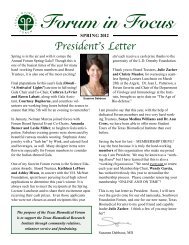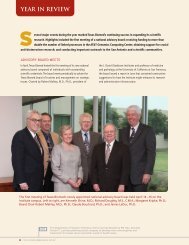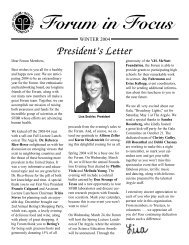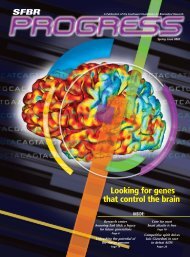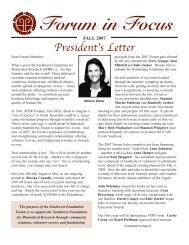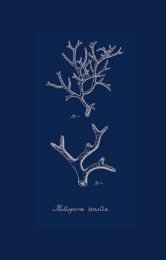Texas Biomed Science Report 2011-2012 - Texas Biomedical ...
Texas Biomed Science Report 2011-2012 - Texas Biomedical ...
Texas Biomed Science Report 2011-2012 - Texas Biomedical ...
Create successful ePaper yourself
Turn your PDF publications into a flip-book with our unique Google optimized e-Paper software.
Timothy J. C. Anderson<br />
Scientist, Genetics<br />
Parasitic diseases still plague broad swaths of the world’s developing<br />
countries, reducing childhood survival rates and stunting economic<br />
growth. However, genome sequence data for the pathogens involved<br />
and funding from organizations such as the Bill and Melinda Gates<br />
Foundation have generated new hope of controlling or even eliminating<br />
these diseases.Anderson’s laboratory focuses on two of the most<br />
important human parasites — malaria, caused by the protozoan<br />
Plasmodium falciparum, and schistosomiasis, caused by the blood fluke in<br />
the genus Schistosoma.<br />
Malaria infects around 500 million people each year, killing<br />
1.7 million-2.5 million people. There is currently no vaccine and<br />
resistance to all five classes of antimalarial drugs has now been reported.<br />
Anderson’s laboratory is using three different strategies to identify<br />
genes that underlie resistance. First, they are using genome-wide<br />
association methods to systematically search for the genes involved.<br />
As the malaria genome is relatively small, they can use whole genome<br />
sequence information from populations of parasites to achieve this goal.<br />
Second, they are examining the role of copy number variation; already<br />
this approach has characterized an important gene involved in drug<br />
resistance. Finally, they are selecting resistant parasites in the laboratory<br />
and using next-generation sequencing methods to identify the genetic<br />
changes that have occurred. Their work involves collaborators in South<br />
America, Africa and Southeast Asia.<br />
Schistosomiasis — otherwise known as Bilharzia — is caused by blood<br />
flukes (Schistosoma spp.). These parasites infect over 270 million people<br />
in Africa, South America and Asia, and utilize snail intermediate hosts.<br />
Staff<br />
Left to right: Claudia Valentim,<br />
Shalini Nair, Ian Cheeseman,<br />
Tim Anderson, Standwell Nkhoma<br />
<strong>2011</strong>–<strong>2012</strong> Scientific <strong>Report</strong><br />
“Our primary aim is to identify the genes that underlie drug resistance in the malaria parasite<br />
Plasmodium falciparum and the parasitic fluke, Schistosoma mansoni.<br />
Identification of these genes will allow us to monitor resistance spread in the field,<br />
to redesign drugs to restore efficacy, and to better understand the dynamics of resistance evolution.”<br />
Publications<br />
• Nair S, Williams JT, Brockman A, Paiphun L, Mayxay M, Newton PN, Guthmann J-P, Smithuis<br />
FM, Tran Tinh Hien, White NJ, Nosten F, Anderson TJC (2003) A selective sweep driven by<br />
pyrimethamine treatment in SE Asian malaria parasites. Mol Biol Evo. 20:1526-1536.<br />
• Roper C, Pearce R, Nair S, Sharp BL, Nosten F, Anderson TJC (2004) Intercontinental spread<br />
of pyrimethamine resistant malaria parasites. <strong>Science</strong> 305:1124.<br />
• Nair S, Miller B, Barends M, Jaidee A, Patel P, Mayxay M, Newton P, Nosten F, Ferdig MT,<br />
Anderson TJC (2008) Adaptive copy number evolution in malaria parasites. PLoS Genetics<br />
4:e1000243.<br />
• Criscione CD, Valentim CLL, Hirai H, LoVerde PT, Anderson TJC (2009) A genomic linkage<br />
map for the human blood fluke Schistosoma mansoni. Genome Biology 10: R71.<br />
• Anderson TJC, Nair S, Nkhoma S, Williams JT, Imwong M, Yi P, Socheat D, Das D,<br />
Chotivanich K, Day NPJ, White NJ, Dondorp AM (2010) High heritability of malaria parasite<br />
clearance rate indicates a genetic basis for artemisinin resistance in Western Cambodia.<br />
J Infect Dis 201:1326-30.<br />
• Anderson TJC, Nkhoma S, Ecker AE, Fidock DA. (<strong>2011</strong>) How can we identify parasite genes<br />
that underlie antimalarial drug resistance? Pharmacogenomics 12, 59-85.<br />
The adult worms live in the blood vessels, but the eggs cause pathology<br />
by lodging in the liver or intestine wall, where granulomas form,<br />
resulting in periportal fibrosis and hepatosplenic disease. Anderson’s<br />
work with schistosomes uses a different approach to genetic mapping.<br />
He has conducted genetic crosses in the laboratory to generate the first<br />
genetic map for a human helminth parasite. This allowed him to assign<br />
most of the fragmented genome sequence to individual chromosomes.<br />
Anderson and colleagues are now exploiting this map and using linkage<br />
mapping methods to identify genes that underlie oxamniquine and<br />
praziquantel resistance and other biomedically important traits such<br />
as host specificity. The schistosome research involves collaborators<br />
at the UT Health <strong>Science</strong> Center San Antonio, Italy and the UK.<br />
E For more information, please visit www.txbiomed.org/departments/<br />
genetics/genetics-staff-bio?u=4<br />
9



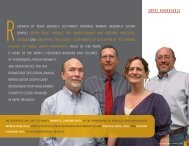
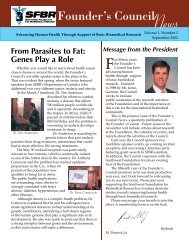
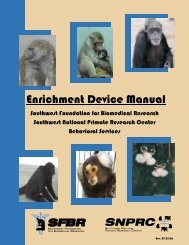
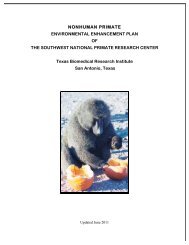
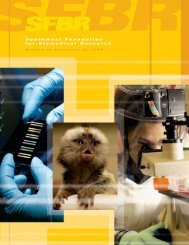
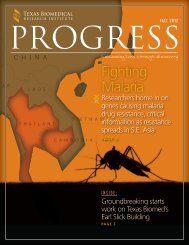
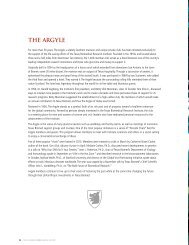
![Vol. 8 No. 2, 2011 [PDF] - Texas Biomedical Research Institute](https://img.yumpu.com/35688099/1/190x245/vol-8-no-2-2011-pdf-texas-biomedical-research-institute.jpg?quality=85)
